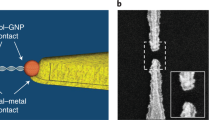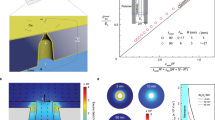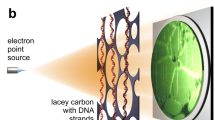Abstract
Attempts to infer DNA electron transfer from fluorescence quenching measurements1,2,3,4,5,6,7,8,9 on DNA strands doped with donor and acceptor molecules have spurred intense debate10,11 over the question of whether or not this important biomolecule is able to conduct electrical charges. More recently, first electrical transport measurements on micrometre-long DNA ‘ropes’12, and also on large numbers of DNA molecules in films13, have indicated that DNA behaves as a good linear conductor. Here we present measurements of electrical transport through individual 10.4-nm-long, double-stranded poly(G)-poly(C) DNA molecules connected to two metal nanoelectrodes, that indicate, by contrast, large-bandgap semiconducting behaviour. We obtain nonlinear current–voltage curves that exhibit a voltage gap at low applied bias. This is observed in air as well as in vacuum down to cryogenic temperatures. The voltage dependence of the differential conductance exhibits a peak structure, which is suggestive of the charge carrier transport being mediated by the molecular energy bands of DNA.
This is a preview of subscription content, access via your institution
Access options
Subscribe to this journal
Receive 51 print issues and online access
$199.00 per year
only $3.90 per issue
Buy this article
- Purchase on Springer Link
- Instant access to full article PDF
Prices may be subject to local taxes which are calculated during checkout




Similar content being viewed by others
References
Arkin, M. R. et al. Rates of DNA mediated electron transfer between metallointercalators. Science 273, 475–480 (1996).
Lewis, F. D. et al. Distance-dependent electron transfer in DNA hairpins. Science 277, 673–676 (1997).
Barbara, P. F. & Olson, E. J. C. Ch. 13 (Advances in Chemical Physics Vol. 107, Wiley & Sons, 1999).
Meggers, E., Michel-Beyerle, M. E. & Giese, B. Sequence dependent long range hole transport in DNA. J. Am. Chem. Soc. 120, 12950–12955 (1998).
Beratan, D. N., Priyadarshy, S. & Risser, S. M. DNA: insulator or wire? Chem. Biol. 4, 3–8 (1997).
Wan, C. et al. Femtosecond dynamics of DNA mediated electron transfer. Proc. Natl Acad. Sci. USA 96, 6014–6019 (1999).
Henderson, P. T., Jones, D., Hampikian, G., Kan, Y. & Shuster, B. G. Long-distance charge transport in duplex DNA: the phonon-assisted polaron-like hopping mechanism. Proc. Natl Acad. Sci. USA 96, 8353–8358 (1999).
Jortner, J., Bixon, M., Langenbacher, T. & Michel-Beyerle, M. E. Charge transfer and transport in DNA. Proc. Natl Acad. Sci. USA 95, 12759–12765 (1998).
Grozema, F. C., Berlin, Y. A. & Siebbeles, L. D. A. Sequence dependent charge transfer in donor-DNA-acceptor systems: a theoretical study. Int. J. Quant. Chem. 75, 1009–1016 (1999).
Taubes, G. Double helix does chemistry at a distance—but how? Science 275, 1420–1421 (1997).
Wilson, E. K. DNA conductance still confounds. Chem. Eng. News 2751–2754 (1998).
Fink, H. W. & Schönenberger, C. Electrical conduction through DNA molecules. Nature 398, 407–410 (1999).
Okahata, Y., Kobayashi, T., Tanaka, K. & Shimomura, M. Anisotropic electric conductivity in an aligned DNA cast film. J. Am. Chem. Soc. 120, 6165–6166 (1998).
Elley, D. D. & Spivey, D. I. Semiconductivity of organic substances. Trans. Faraday Soc. 58, 411–415 (1962).
Hutter, M. & Clark, T. On the enhanced stability of the guanine-cytosine base-pair radical cation. J. Am. Chem. Soc. 118, 7574–7577 (1996).
Bezryadin, A. & Dekker, C. Nanofabrication of electrodes with sub-5 nm spacing for transport experiments on single molecules and metal clusters. J. Vac. Sci. Technol. B 15, 793–799 (1997).
Bezryadin, A., Dekker, C. & Schmid, G. Electrostatic trapping of single conducting nanoparticles between nanoelectrodes. Appl. Phys. Lett. 71, 1273–1275 (1997).
van Lith, D., Warman, J. M., de Haas, M. P. & Hummel, A. Electron migration in hydrated DNA and collagen at low temperatures. J. Chem. Soc. Faraday Trans. 1 82, 2933–2943 (1986).
Datta, S. et al. Current-voltage characteristics of self-assembled monolayers by scanning tunneling microscopy. Phys. Rev. Lett. 79, 2530–2533 (1997).
Grabert, H. & Devoret, M. H. Single Charge Tunneling (Plenum, New York, 1992).
Bakhshi, A. K. Investigation of electronic conduction in proteins and DNA. Prog. Biophys. Mol. Biol. 61, 187–253 (1994).
Ladik, J. Energy bands in DNA. Int. J. Quantum Chem. 4, 307–317 (1971).
Acknowledgements
We thank L. Gurevich for assistance in the fabrication and measurements; E. W. J. M. van der Drift, A. van der Enden, L. E. M. de Groot, S. G. Lemay, A. K. Langen-Suurling, R. N. Schouten, Z. Yao, T. Zijlstra, M. R. Zuiddam, M. P. de Haas, J. M. Warman, A. Storm, N. Kemeling and J. Jortner for assistance and discussions; and E. Kramer and E. Yildirim for the DNA characterization measurements. This work was supported by the Dutch Foundation for Fundamental Research on Matter (FOM).
Author information
Authors and Affiliations
Rights and permissions
About this article
Cite this article
Porath, D., Bezryadin, A., de Vries, S. et al. Direct measurement of electrical transport through DNA molecules. Nature 403, 635–638 (2000). https://doi.org/10.1038/35001029
Received:
Accepted:
Issue Date:
DOI: https://doi.org/10.1038/35001029
This article is cited by
-
Multi-exciton transfer in a biomolecular system
Nonlinear Dynamics (2024)
-
Rapid genetic screening with high quality factor metasurfaces
Nature Communications (2023)
-
Charge transport in individual short base stacked single-stranded RNA molecules
Scientific Reports (2023)
-
Electron transfer-triggered imaging of EGFR signaling activity
Nature Communications (2022)
-
Comparative study of symmetrical and asymmetrical B40 molecular junctions
Journal of Computational Electronics (2022)
Comments
By submitting a comment you agree to abide by our Terms and Community Guidelines. If you find something abusive or that does not comply with our terms or guidelines please flag it as inappropriate.



